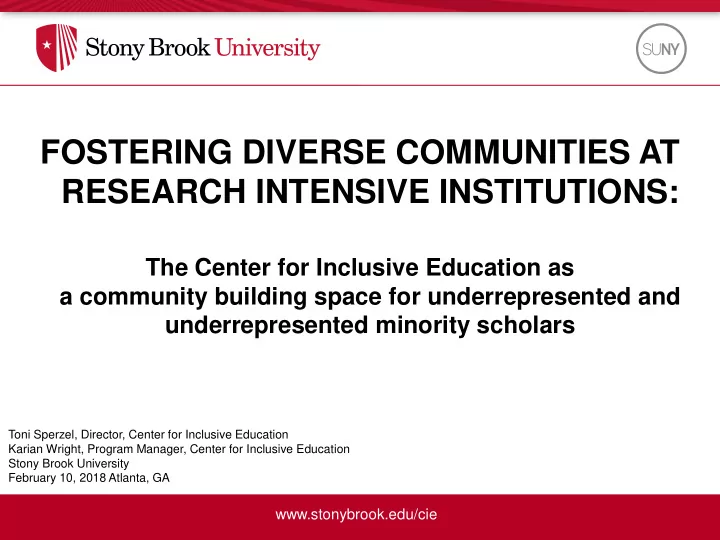

FOSTERING DIVERSE COMMUNITIES AT RESEARCH INTENSIVE INSTITUTIONS: The Center for Inclusive Education as a community building space for underrepresented and underrepresented minority scholars Toni Sperzel, Director, Center for Inclusive Education Karian Wright, Program Manager, Center for Inclusive Education Stony Brook University February 10, 2018 Atlanta, GA www.stonybrook.edu/cie
• If a scientific team wants to be innovative, it must be diverse. Psychology, sociology, economic and demographic research continues to prove that diversity makes us smarter (Page, 2008). • With the ever-increasing diversity of our population, it is a national imperative that institutions of higher education take responsibility for preparing all scholars to communicate, collaborate, and innovate within a diverse community of scientists from a position of respect, understanding and advocacy. Failure to do so will continue the trend of diverse scholars choosing to leave the STEM career pathway, which will directly impact our nation’s ability to grow and maintain a productive STEM workforce (National Academies, 2007).
• The departure of underrepresented scholars from STEM fields is occurring at an alarming rate. • Women and ethnic minority groups are now estimated to make up 70% of college-aged students, but only 45% of students who receive STEM undergraduate degrees (Olson & Riordan, 2012). • This data does not even consider the number of scholars who identity as disabled, veteran, or coming from a poverty-level economic background, or scholars who may identify as members of the lesbian, gay, bisexual, transgender and queer (LGBTQ*) community, a group which recent data reports have also shown to experience discrimination, discomfort, isolation and exclusion in STEM fields (Atherton et al., 2016; Partridge, Barthelemy & Rankin, 2014; Moran, 2017).
When a stigmatized person becomes aware that their stigmatized status may be relevant in a particular context, they may become vigilant and increase attention for environmental cues relevant to potential prejudice and discrimination. • Critical to STEM graduate student success, stereotype threat can lead to: – Reduced Openness to Feedback – Reduced Domain Identification – Reduced Engagement – Reduced or Changed Career Aspirations (Casad & Bryant, 2016) These reductions directly impact persistence in STEM disciplines
When underrepresented graduate students perceive that faculty in their academic environment value natural intelligence (Fixed Mindset) and brilliance over hard work (Growth Mindset) and effort, it undermines their sense of belonging and confidence. This perception sets a groundwork for future experiences of facing advisors and mentors who take a “fixed intelligence” approach to interacting with their protégés (Dweck, 2006, Clark, Dyar, Maung, & London, 2016).
1) Create Community – connecting underrepresented minority (URM) scholars across academic programs to create connections and foster sense of belonging 2) Engage Academic Departments- work with graduate programs to identify critical junctures in degree pursuit where URM scholars encounter academic, research, and identity obstacles 3) Provide Peer mentorship – Connect Scholars across career points to share just-in-time guidance and support through critical junctures in the PhD pathways 4) Create opportunities for peers to share the community value and public impact of their research efforts (Gibbs & Griffin, 2013)
Integrate Physical Cues: Including photos and posters of diverse people and groups engaged in research activity
Signal Institutional Valuing of Diversity: Including diverse researchers in departmental events, programming and curriculum
Cultivate a Community of Support: Train advisors and peers on giving wise feedback from a growth mindset perspective (Cohen, Steele, & Ross, 1999; Yeager et al., 2013)
The Center for Inclusive Education Stony Brook University Computer Science Suite 2401 Stony Brook, NY 11794-4422 CIE_graduateschool@stonybrook.edu
References • Atherton, T. J., Barthelemy, R. S., Deconinck, W., Falk, M. L., Garmon, S., Long, E. & Reeves, K. (2016). LGBT Climate in Physics: Building an Inclusive Community. American Physical Society, College Park, MD. • Casad, B.J. & Bryant, W.J. (2016). Addressing Stereotype Threat is Critical to Diversity and Inclusion in Organizational Psychology. Frontiers in Psychology. 7:8. • Clark, S.L., Dyar, C., Maung, N., & London, B. (2016). Psychosocial Pathways to STEM Engagement among Graduate Students in the Life Sciences. CBE Life Sciences Education 15(3), ar45. • Cohen, G. L., Steele, C. M., & Ross, L. D. (1999). The Mentor’s Dilemma: Providing Critical Feedback Across the Racial Divide . Personality and Social Psychology Bulletin, 25(10), 1302-1318. doi:10.1177/0146167299258011. • Dweck, C. S. (2006). Mindset: The new psychology of success. Random House Incorporated. • Gibbs, K. D., Jr., & Griffin, K. A. (2013). What Do I Want to Be with My PhD? The Roles of Personal Values and Structural Dynamics in Shaping the Career Interests of Recent Biomedical Science PhD Graduates. Cell Biology Education, 12(4), 711- 723. doi:10.1187/cbe.13-02-0021. • Moran, B. (2017). Is Science Too Straight? LGBTQ+ issues in STEM diversity. Retrieved from http://www.bu.edu/research/. • National Academy of Sciences, National Academy of Engineering, and Institute of Medicine. (2007). Rising Above the Gathering Storm: Energizing and Employing America for a Brighter Economic Future. Washington, DC. The National Academies Press. • Olson, S., & Riordan, D. G. (2012). Engage to Excel: Producing One Million Additional College Graduates with Degrees in Science, Technology, Engineering, and Mathematics. Report to the President. Executive Office of the President. • Page, S. E. (2008). The difference: How the power of diversity creates better groups, firms, schools, and societies. Princeton University Press. • Partridge, E.V., Barthelemy, R.S., & Rankin, S.R. (2014). Factors Impacting the Academic Climate for LGBQ STEM Faculty. Journal of Women and Minorities in Science and Engineering. 20(1) 75-98. • Yeager, D. S., Purdie-Vaughns, V., Garcia, J., Apfel, N., Brzustoski, P., Master, A., & Cohen, G. L. (2014). Breaking the cycle of mistrust: Wise interventions to provide critical feedback across the racial divide. Journal of Experimental Psychology: General, 143(2), 804.
Recommend
More recommend